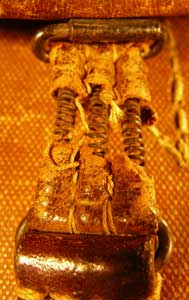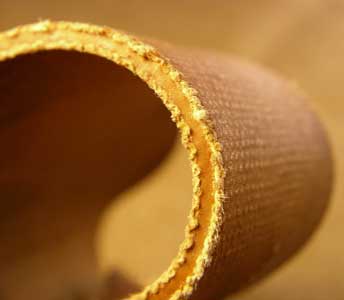Nambu
World: Type 14 Holster-JMCH VIII
The war stretched

Here is the back showing the belt loop and the
black-lacquered steel D-rings for the shoulder strap.

This shot shows the holster open

Here you can see that the closure
strap has seen better days. The very thin leather over the springs is an early
wear point on all the holsters with the spring-loaded closure strap. This one
is actually the best of the half-dozen or so transitional holsters I considered
over three years before buying one.

The plus side of getting a holster with wear to
this area is that you can see exactly what is inside. Here you can see the
three springs from the front.

The same part shown from the back (underneath).

These markings are found in the
usual place, in the centre of the broad flat area inside the clamshell flap.
They are faint but the top row is still clearly legible. The bottom row is only
recognizable if you know what the symbols are likely to be; you could not decipher
them otherwise. Let’s start with the top row. The upper left character is Sho as in Showa, the name of Emperor
Hirohito’s reign. The two characters to the right of that are a ten and a six (the middle one is the ten
and looks like a plus sign). Together they indicate the holster was made in the
sixteenth year of the reign of Emperor Hirohito. Showa 16 translates into 1941
in the Western calendar. Most sources indicate the use of rubberized canvas
began in 1942, so this must be one of the earliest holsters to use that
material. The bottom row has a faint circular symbol under the “plus sign
(kanji ten)” in the top row. That is a Nagoya Arsenal symbol. To the right of
that is a blurry character that looks like it has a small square in the lower
right part of it. That is a kanji na,
used as an inspection symbol by Nagoya Arsenal.

This is a close-up of the upper edge
of the holster body to show the construction of the rubberized canvas material
(the reddish-brown area at the top of the holster is the top of the ammo pouch
flap and the black area at the bottom is the interior of the holster). Note
that there are three layers of canvas (the lighter layers in the photo) and two
layers of latex (the reddish layers). Rubberized canvas gave superior service
in tropical environments because it did not rot like leather. However, in the longer
term it usually becomes rock hard and the layers can separate if an attempt is
made to bend them. However, from my limited sampling it seems like the earliest
holsters tended to retain their flexibility a bit better (I speculate on the
reason why below). In this case the body of the holster still retains some
ability to expand; I once had a later Type IX that had become completely hard
and was frozen in a position that did not allow a pistol to be inserted.

This is a close-up of the ammo pouch
flap. Since this flap must open and close, it is one of the parts of the
holster where flexibility is most critical. On this one and my earliest Type
IX, the flap remains very soft and flexible, and I think this photo shows why. Note
how thick the latex layer is between the two layers of canvas. My later
rubberized canvas holsters have much less flexibility in the flap and much
thinner layers of latex. Of course, when these holsters were made, no one was
thinking about how flexible they would be sixty-plus years later.

This photo shows just how flexible the ammo
pouch flap is. On many later holsters any attempt to flex the flap results in
separation of the material.

The use of leather was continued for
a variety of small bits where flexibility was important. The largest piece of
leather is the hinge that joins the clamshell flap to the body of the holster.

The toe cap is also leather.

Along the rear edge a thin strip of leather
is used as a spacer. The short piece where there are two layers of leather is
the outside of the loop for the cleaning rod, which fits inside the holster
along the rear edge. Besides the hinge, toe cap, cleaning rod loop and this
spacer, the other small leather bits are the closure strap tab and spring
covers; the edging on the clamshell; the inner spacer blocks; and reinforcing
patches for the closure studs for on the holster body and the ammo pouch. These
items continued to be made of leather even after the changeover to “all”
rubberized canvas (i.e. for both the clamshell flap and the body). In the Type
X holster they also reverted to making the spare striker pocket out of leather,
after using rubberized canvas in the Type IX.

Click here to go back to the Type 14
Accessories page: t14accessories.htm
Click here to go back to the main page: jhg.htm
Last updated: June 27, 2006. All contents are
copyright Teri unless otherwise specified and may not be used elsewhere in any
form without prior permission.